The Perpetual Content Calendar: A 3-Step Framework to Generate Content with a Lean Team
- July 7, 2020
- Uncategorized
We can confidently say—we’re not the only ones that are telling you content is important. You’ve heard about it in the marketing world and the way business owners, agencies, and marketers talk about it…it seems like a big deal.
It also seems like a huge (huge, huge) time commitment.
I mean, there are just so many platforms out there that demand consistent content:
- Blogs
- YouTube
- Snapchat
- Podcasts
- Gated content
And within each of those platforms there are multiple content types:
- Text
- Video
- Photo
- Audio
If you’re feeling like slowly backing away from this article and pretending that you never read so you don’t need to start such a massive content commitment—we get it. But don’t stray too far just yet, because we’re going to show you how to turn this  into a
into a  .
.
Creating all these different pieces of content for all of these different platforms might not be a problem for a huge company with a giant team of people dedicated solely to content creation. But what about the rest of us?
What’s a small, lean team to do?
By the end of this post, you’ll have a 3-step system you can use to efficiently develop consistent, high-quality content with a lean team.
Here’s how it works.
The 3-Step Perpetual Content Process
Is there a way to pump out more content—good content, mind you—without spending every waking hour sitting at the keyboard, staring into a microphone, or standing in front of a camera?
Yes, there is… and it’s called the 3-Step Perpetual Content Process.
Here’s a quick overview of how it works:
- Ideation: Regularly come up with good content ideas and topics that resonate with your audience.
- Production: Once you have a list of topics, you turn those ideas into great pieces of content.
- Splintering: This is my favorite part of this system. It’s the process of taking 1 great piece of content and turning it into multiple different assets that you can leverage on all your different content platforms.
Let’s go deeper into each of these steps so you can start churning out some damn good content.
Step 1: Ideation
The first step in content creation is to decide what topics you’re going to cover. So how do you figure this out?
A lot of people get overwhelmed at this stage. They don’t even know where to start. But it’s pretty simple when you follow this 3-step process.
#1: Find out what questions people are asking in your industry
Want to know the trick to coming up with great content ideas quickly & easily? Start with the questions your customers are already asking.
And as long as you know where to look, that’s really easy to do. Cue the places to find great content ideas for your business:
- Quora: This is a great place to find real questions being asked by real people. The questions are sorted by topic, making it easy for you to find the questions that are relevant to your business. This is a fantastic place to find out what kind of problems your target market is having right now.
- Reddit: Reddit is one of the biggest sites on the internet, and it’s packed with highly engaged subcommunities (called subreddits) of people who are interested in a wide variety of different topics. Another great resource.
- Facebook Groups: These days, there’s a Facebook group for just about any interest you can think of—from digital marketing to Harry Potter fan fiction and much, much more. So, find and join a few groups that are relevant to your business. You’ll get instant access to insightful conversations taking place among your audience.
- Ask Your Real Customers: This one seems obvious, but it’s so obvious that it’s easy to forget. You already have access to a group of people in your industry… your customers! So reach out to them. Have conversations—whether it’s an email, a poll, a survey, whatever. Find out what’s on their mind and what they’d like to know.
Those are great places to find out what kind of questions people are asking in your industry. And there’s one more tool that I recommend using in conjunction with those sources—and that’s a keyword planner.
Using a keyword research tool (like Keywords Everywhere or SEMrush), you can find the search volume for the questions that you discovered above. When you search in Google, the Keywords Everywhere Chrome browser extension will show approximately how many searches are being performed every month for your searched term:
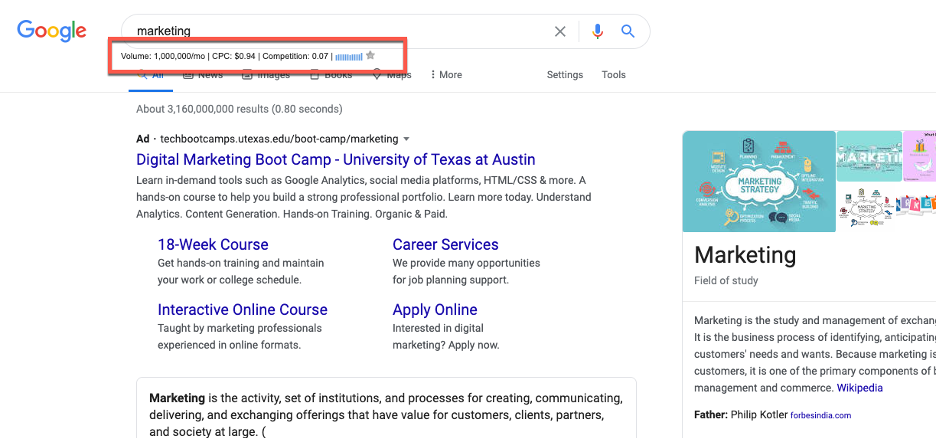
You can also use the Keywords Everywhere to find new keyword ideas that are related to your existing keywords. Just scroll down and it will give you related keywords and other searches people make about that topic:
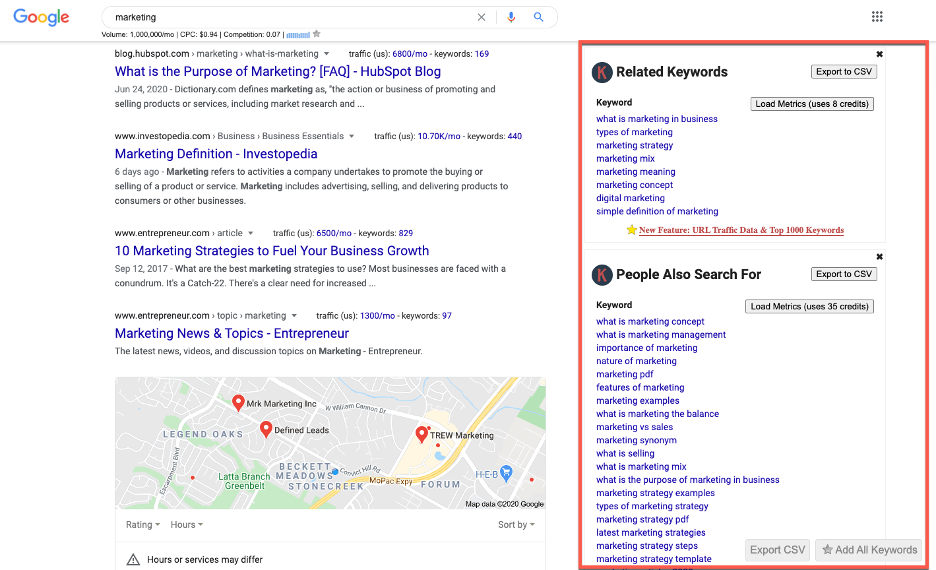
So once you get a list of relevant blog topics from the sources above, it’s a good idea to do a little keyword research to find out which questions are being asked most often. That way, you can prioritize your content creation to start with the highest-volume questions first.
#2: Break each question down into multiple topics
OK, so at this point, you have a list of questions—things your customers want to know. But one thing you’ll notice at this stage is that each question in your list can lead to multiple content topics.
A question about how to get more B vitamins, for example, can lead to all sorts of content topics: symptoms of vitamin B deficiency, why B vitamins are important, recipes that are high in vitamin B, and so on.
So the next thing I do is take my list of questions and break them down into as many potential content ideas as I can think of. And when I’m done with that, I move on to…
#3: Turn each topic into a headline
Now you have a list of specific content topics. The last thing you need to do is take these topics and convert them into headlines. The headline is going to be the title of your content, the thing people see when it shows up on Facebook or in Google’s search results.
Some people may be wondering: why do you need to write the headline first? Can’t you write the content first, and then give it a headline later?
Well, technically you can. But I recommend writing the headline first, and doing it yourself, for a couple of reasons:
- A good headline will give your content a “hook,” something that makes it interesting. Knowing your hook up-front can help you to create better, more interesting content.
- The headline is the most important part of your article, so it’s worth taking the time to make it a good one.
- If you’re outsourcing the blog-writing process to a ghostwriter, having a good headline for them can help ensure that they know exactly what kind of article you want them to write.
When you’re going through this process, keep in mind it’s important to have your headlines speak to the desired end result. Think about what the person wants to have happen. That is what you want to talk about in your headlines.
And whatever you do, don’t write about yourself here. Instead, try to think about each topic from your ideal prospect’s point of view: how do they feel about it? What problems are they having? What do they want to know?
Now before we move on to Step 2, let’s walk through an example of Step 1 so you can see how this works in practice.
Ideation Example
For the examples in this post, let’s imagine we own a vegan dinner subscription service, like BlueApron for the vegan industry.
We want to create content that is going to appeal to our target market—vegans who might want to subscribe to our service.
1) Find out what questions people are asking in your industry
Let’s look for the questions people are asking about veganism on Quora. Search “Vegan” on Quora and here are a few responses you’ll see:
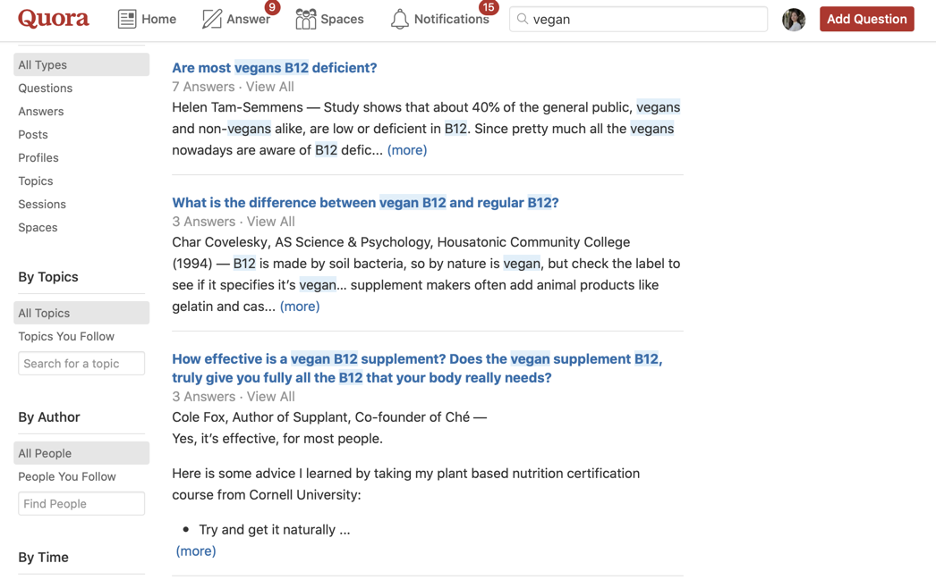
Since there are a lot of questions around the vitamin B12—this looks like a great topic to write content around;
2) Break each question down into multiple topics
The next step is to turn that question into multiple topics. Just brainstorm as many relevant topics as you can think of. Here are a few examples:
- Where to get vitamin B12
- Why B12 is important
- What can happen if you don’t get enough B12
- Vegan recipes you can make to get enough more B12
- Whether it’s better to get B12 with supplements or with food
3) Turn each topic into a headline
And finally, we want to turn each of those topics into a headline. Here are some examples of headlines I might create based on those topics:
- What is Vitamin B12, and Why Do We Need It?
- 7 Foods Rich in B12 for a Healthy Vegan Diet
- How to Incorporate B12 into Your Vegan Diet
- What Happens to Your Body When You’re Deficient in B12
- 15 Vegan Recipes Full of Vitamin B12
And voila! Here you can see we’ve taken 1 question and turned it into 5 new content ideas. Each of these headlines would make a great post for our vegan meal subscription service.
#2: Production
At this point we have a list of great ideas for new content pieces. Now let’s turn those ideas into some real pieces of content!
The process I follow, and that I recommend to others, is to start with a video first. Then, turn that video into a blog post. If you follow this process, you’ll be able to quickly and easily splinter those 2 pieces of content into all sorts of content assets in step 3.
So first things first, let’s make a video (and then turn that video into a blog post).
How to Create Your Video
Now some people might be intimidated at this prospect. Isn’t video hard?
Actually, no. Video doesn’t have to be hard at all.
Keep in mind this does NOT have to be some elaborately produced video with special effects, music, voiceovers, and animations. All you really need is a computer with a microphone and some screen-capturing software like Camtasia (for PCs) or ScreenFlow (for Macs).
If you have those 2 things, then all you have to do is (1) create a slide deck on your topic. And then (2) sit down in front of your mic, start recording your screen, and talk about the topic while you go through the deck.
(I’ve found that 45 minutes is the sweet spot for these kinds of videos).
After all, you’re a marketer. You’re well-versed in your industry. And I’m willing to bet that you’re perfectly capable of sitting down and talking about the topics that are relevant to your business.
Trust me, it’s easier than it sounds. Just try it. Remember, if you slip up along the way you can always start over or edit out your mistakes.
How to Create Your Blog Post
Now that your video is created, turning it into a blog post is easy. Either you can write the post or you can outsource it to a professional content writer. You can use platforms like Upwork or Fiverr, or connect with writers using The Writer Finder or DemandCurve.
Just send your video to a ghostwriter and have them turn it into an article. There are all kinds of options there for you, so you’re sure to be able to find a good writer who fits in your budget.
To attract a good writer, but not break the bank you can expect to pay about $250 per 2,000-word post. Trust me, $250/post is a loooot cheaper than hiring a full-time content writer of your own.
If you follow this process, then you’ll have 2 pieces of high-quality content: 1 video and 1 blog post. Before we move on to the final step, Splintering, let’s take a look at how you’ll turn your video into a blog article.
Production Example
We recently ramped up our Youtube channel—which means that every educational video we publish we’re turning into an article for our blog. Here’s an example of a Youtube video we posted titled Create a Customer Avatar in 5 Easy Steps:
And here’s the article we wrote based on the video, Create a Customer Avatar in 5 Easy Steps. Pretty cool stuff, huh?
Now, let’s move on to the last step of the Perpetual Calendar Framework.
Step 3: Splintering
If you’re not familiar with the term splintering, basically it’s the process of breaking bits and pieces off of your existing content and sharing them through your distribution channels.
In other words, it’s where you turn 1 piece of content into many pieces of content. And we’re going to do this for both your video and your blog.
How to Splinter Your Video
You know that 45-minute video you made? Here’s what you want to do with it:
- Splinter the video into a blog post. (You already did this in the last step
 )
) - Use the video as a piece of content itself—I recommend using it as a gated webinar to collect leads
- Cut up the video into enticing clips for social media
In other words, if people want to watch the entire video, then can, for free! They’ll just have to opt-in to get it which helps you to grow your email list.
And in the meantime, you can post bits and pieces of that video on YouTube, Instagram, Facebook, etc.
How to Splinter Your Blog Post
Your next step is to splinter your blog. Here’s what you need to do:
#1: Read through your blog and identify any important quotes. This could be any insightful sentence or phrase—basically, you’re finding all your quotable moments.
#2: Next, identify any interesting statistics or important numbers that are cited in your blog.
#3: Finally, identify any important lists or processes that are explained in your post. This could be a step-by-step guide, a list of items or ideas, anything like that.
Now you just need to take these things (your quotes, statistics, and lists/processes) and turn them into social media images using Adobe Spark or Canva.
Let’s see how this splintering process works.
Splintering Example
Let’s imagine that the 45-minute video we created was on the topic of vitamin B12. How would we splinter that?
Well, we’d watch through the entire video and pay attention for anything that could make a good self-contained clip on a certain topic. For example, maybe we discover…
- A 3-minute segment on the best natural foods to get B12
- A 5-minute segment talking about your favorite B12 supplement
- A 2-minute segment explaining your favorite vegan recipe that’s high in B12
Just use your video editing software to turn each of those little clips into a separate video. Then post them on your distribution channels. Short videos like this (say 1-5 minutes) tend to work really well, because they’re short enough that people can stop and watch on a whim, but they’re long enough to have some meaty content.
For example, we had Billy Gene give a video workshop on Creating Video Ads That Sell. We took that workshop, and turned it into a blog post:
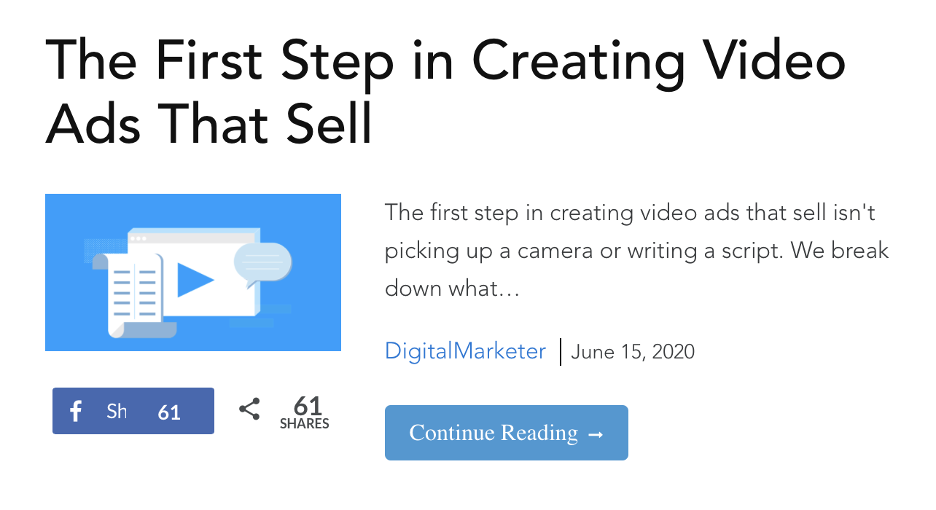
Then, we took that blog post and turned it into an Instagram post:
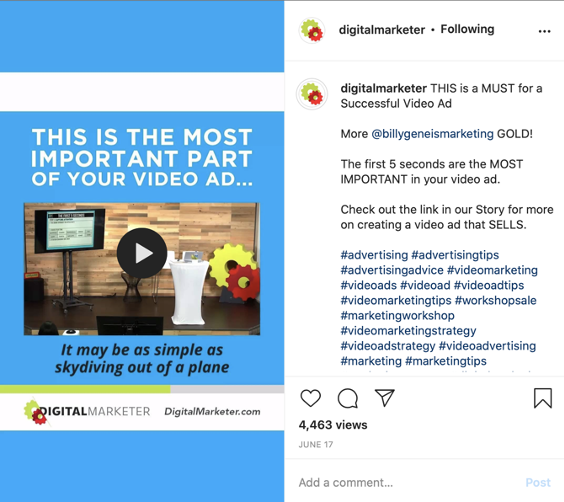
To keep splintering it, we could turn it into Instagram stories, Tweets, LinkedIn posts, etc. until we’ve maxed out what we can create from this one video (kudos to Billy Gene!).
Cool, huh?
These kinds of images tend to do really well on social media because they’re visually bold, they stand out in a newsfeed, and they contain 1 punchy message.
Now, let’s put it all together on your Perpetual Content Calendar.
Create Your Content Calendar
Now’s a good time to stop and take a look at what you’ve accomplished.
You sat down and created 1 piece of content—a 45-minute video where you just chatted about a topic that you’re already well-versed on.
From there, you outsourced a blog post and then splintered each of those assets into several smaller chunks of shareable content.
Maybe you ended up with 3 splinter videos and 5 social media images in addition to the blog and video itself. Resulting in 10 total pieces of content for you to publish and post:
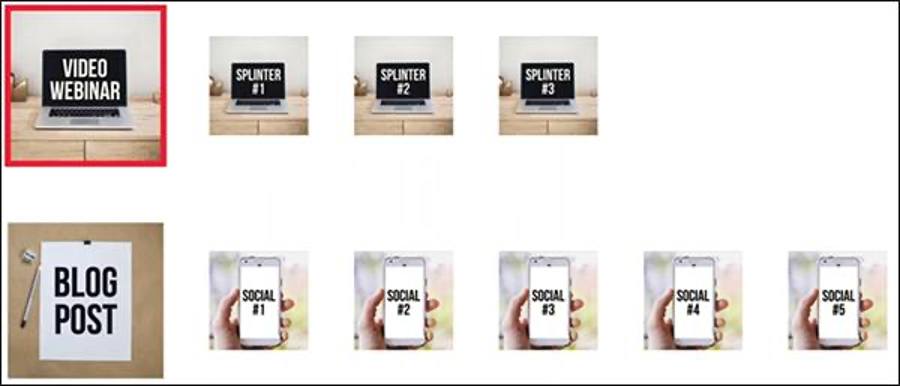
You’re almost there—but you’re not quite done yet.
The next thing you’ll want to do is schedule these content pieces on a content calendar using a scheduling platform like Hootsuite, ZohoSocial, Buffer, etc.
Basically, you’re deciding ahead of time when you’re going to share each individual asset.
This way, you can spread out how often you are posting content related to this 1 topic. Here’s what your calendar might look like:
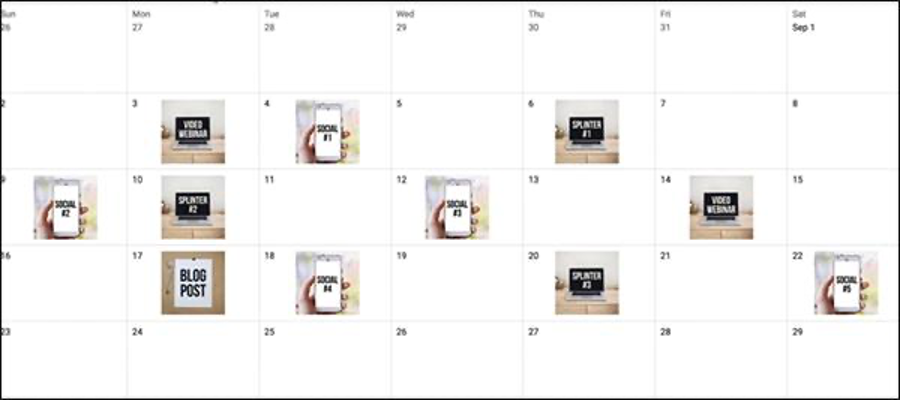
The coolest thing is that all these social media posts originated from ONE piece of content that only took you 45 minutes to record.
It’s a really powerful system you can leverage to create the maximum amount of high-quality content in a minimal amount of time.
Even if you don’t have a huge team, you can still be on top of your content game. Use the Perpetual Content Calendar to create never-ending content that builds awareness and converts content viewers into subscribers.
The post The Perpetual Content Calendar: A 3-Step Framework to Generate Content with a Lean Team appeared first on DigitalMarketer.
About us and this blog
We are a digital marketing company with a focus on helping our customers achieve great results across several key areas.
Request a free quote
We offer professional SEO services that help websites increase their organic search score drastically in order to compete for the highest rankings even when it comes to highly competitive keywords.
Subscribe to our newsletter!
More from our blog
See all postsRecent Posts
- Web Hosting September 26, 2023
- Affiliate Management September 26, 2023
- Online Presence Analysis September 26, 2023


